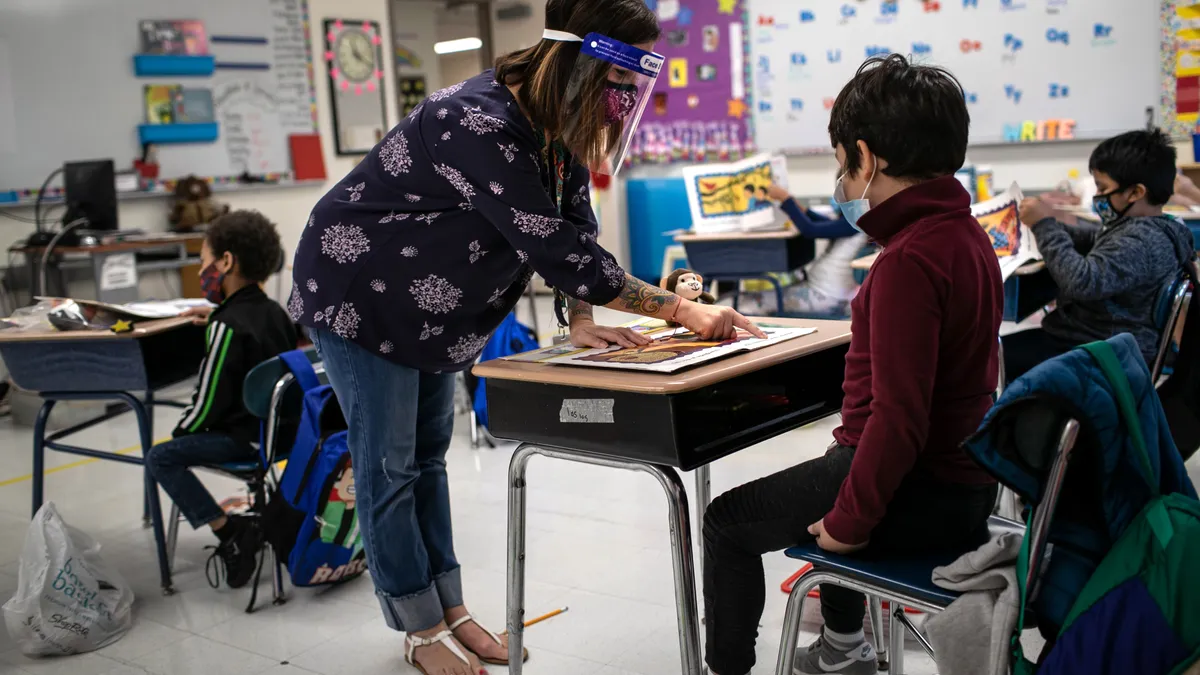Dive Brief:
-
Fewer schools are offering remote and hybrid options this school year than last, according to new data from the National Center for Education Statistics. Meanwhile, nearly all public schools are offering in-person instruction in a sharp reversal from the first year of the pandemic.
-
At the end of last school year, about 40% of schools were offering students a remote option, compared to around 34% as of September 2021. There was an even sharper drop in hybrid learning: While 44% gave that option at the end of last school year, less than 5% offered hybrid learning at the beginning of this school year, according to Chris Chapman, an associate commissioner for NCES.
-
According to the NCES-sponsored School Pulse Panel, which surveyed 170 schools, 100% of schools reported offering full-time, in-person instruction in September. Separate results from NCES’ National Assessment of Educational Progress Pre-Assessment data collection, which included 7,400 schools surveyed between September and December 2021, showed 99% of 4th- and 8th-grade students were enrolled in full-time, in-person instruction.
Dive Insight:
The numbers show a significant shift from the end of the 2020-21 school year, when only 62% of schools offered full-time, in-person instruction. Results from the School Pulse Panel showing 100% of students are now in the classroom outpaced the slightly lower prediction from the Institute of Education Sciences, an arm of the U.S. Department of Education, of 98% for this school year.
“It’s really a response to families and schools and educators really wanting to have students back in the classroom,” said Chapman.
NCES Commissioner Peggy G. Carr called the results “encouraging.” U.S. Secretary of Education Miguel Cardona also said he was “heartened” by the news.
“As a nation, we’re at a place where we do not have to choose between reducing our children’s risk of COVID-19 and keeping them connected to the supports that they need — and to which they often only have access — in school,” added Cardona in an emailed statement to K-12 Dive.
The decrease of both remote and hybrid options comes despite the spread of Delta and the newer Omicron variants and as the White House and health experts stress the importance of keeping schools open.
“Children and adolescents, they need to be in the school building learning in-person,” Linda Mendonca, president of the National Association of School Nurses, told K-12 Dive. “I don’t particularly think that we’ll go backward … of course, it’s all dependent on community transmission.”
However, the move away from remote and hybrid learning runs counter to what educators, think tanks and other education organizations predicted would be a long-term shift in the education system toward virtual options.
Schools are also shying away from offering hybrid and remote learning despite many parents voicing preferences otherwise. According to a poll conducted by the National Parents Union prior to the start of the 2021-22 school year, over half of respondents reported wanting a choice between in-person and remote learning. In an October poll conducted by the organization, 70% of parents said they wanted schools to offer options for in-person, remote and hybrid learning.
Experts have previously pointed out offering options in learning could be a way to turn around dipping enrollment trends and woo parents back into public schools from private, charter or virtual schools.
“Getting kids back to in-person learning had to be a priority this year, but it did not have to mean dismantling all options for families and students,” said Robin Lake, director for the Center on Reinventing Public Education, in an email. “Districts and states can't pretend remote learning will just go away. They have an obligation to invest in making it work well for those who need it.”















